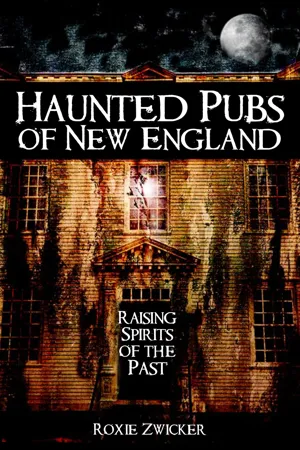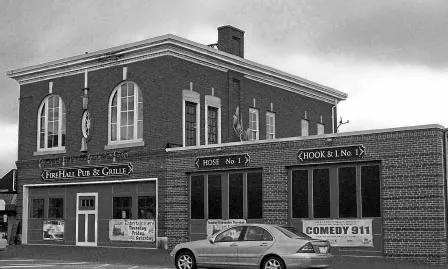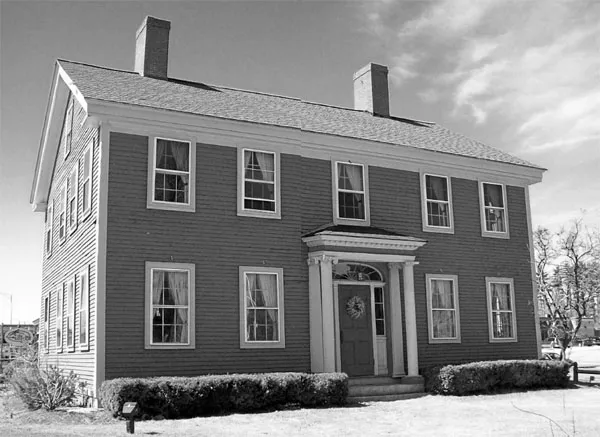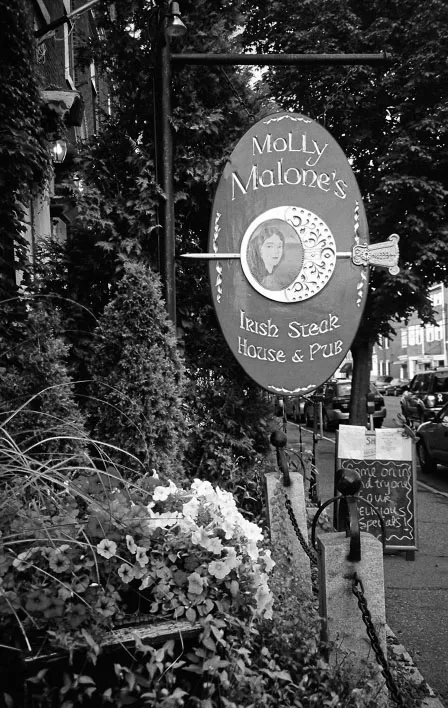![]()
NEW HAMPSHIRE
THE FIREHALL PUB, DERRY
Derry, New Hampshire, is a working-class community and was first settled in 1719 by Reverend Macgregor, of Londonderry, Northern Ireland. The original settlement was called Nutfield. It was not officially incorporated until 1827. Many of the original settlers were from Scotland and Ireland, and as a matter of fact, the name Derry came from its location in Londonderry, Northern Ireland. Local legends claim that the very first potato grown in the United States was planted in Derry.
Before fire departments were established, the townspeople were rallied by the ringing of church bells to put fires out. Given the lack of equipment at the time, firefighting was a monumental task in the early days. People stood in lines forming bucket brigades to put out the fires. The buckets weren’t terribly large either; they held about a gallon of water each.
At a town meeting in 1882, residents decided to establish a formal fire department. A recent devastating fire on Broadway was enough to spur the finalization of a plan. The town purchased a used hand water pumper. A small, wooden engine house was built on Manning Street to house the apparatus. The Industrial Revolution brought about the building of sprawling shoe factories and hundreds of homes for the workers. In 1898, the town settled on building its first formal fire station, Station One, which cost $5,500 to construct. On March 14, 1899, the fire station opened to much fanfare from the townspeople. There were speeches, a full orchestra and, of course, a prayer. A horse-drawn hook and ladder cart and hose carriage were stored on the first floor. The second floor contained a firemen’s meeting hall. Up above the building was a lookout tower and fire signal bell. The horses were kept in a neighboring stable, and their harnesses were suspended from hooks so that they could be readied in less than a minute when the bell rang.
Frank Hurd was Derry’s first full-time fireman, and in 1915 he was paid a salary of fifteen dollars per month. The meeting hall was converted into living quarters so he could be on site. It is said that Frank found the downtime on the job very lonesome, and the stress of being away from his family was quite hard to deal with. The bell tower was the scene of Frank’s suicide. There is no documentation as to why he hanged himself. Some people thought his emotions got to him after the scene of a devastating fire. A ferocious blaze had broken out at the Woodbury Shoe Factory, and two children were killed. Frank had made desperate efforts to save them but was unsuccessful.
The Firehall Pub was Derry’s first fire station.
Eventually, a mechanized fire truck was purchased for $7,000. It was a six-cylinder, one-hundred-horsepower LaFrance pumper. A fine example of a similar vehicle can be seen in nearby Manchester, at the Millyard Museum on the corner of Commercial and Pleasant Streets. The pumper could send a stream of water at the rate of eight hundred gallons a minute, which greatly improved the ability to control future fires. The fire station was enlarged in 1961 after a fire destroyed the Chelmsford Shoe Factory. An addition to the building was made, and it contained two additional bays. Throughout the 1960s, Derry’s population grew rapidly, spurred on by the opening of Interstate 93, which was a direct route to Boston, Massachusetts.
The decision was made to build a larger and more modern fire station to accommodate the growing town. In 1974, the new station was opened, and Station One became a substation. Two years later, the old station was closed, and for the next twenty-five years it served as a fireman’s museum, also housing the town’s historical artifacts and recorded history. In 2003, a proposal for demolition of the unused building was put forth. However, in 2005, Robert and Bonnie Hall stepped forward to save the property and reopened it as the Firehall Pub. Their vision of the pub was to make it a tribute to firefighters, which seemed natural as their son and other family members are firefighters.
The mission statement of the Firehall Pub was, “We are dedicated to our history’s firefighting heroes and the heroes who protect and serve.” During the Halls’ ownership, they filled the pub with everything from uniforms, patch collections and fire helmets to photographs of firefighters doing what they do best. Much of the memorabilia was donated by area firefighters. The front of the pub recalls the building’s history and features two large sliding garage doors. A curious painting used to hang near the bar, and some believe that it may have attracted a spirited presence. The commissioned painting was called The Last Ride, and it depicted a ghostly trio of horses pulling an antique water pumper over a trail ablaze with red flames. Many customers and employees recalled seeing “shadow people” in front of the dramatic painting. Did the eerie image entice passing spirits to visit the former fire station?
According to many people I spoke to who were familiar with the business and the building, the consensus was that there was no doubt that the location was haunted. I was able to take a tour of the building from the basement to the attic crawl spaces. It seemed that everywhere I turned there were stories of ghostly activity. On the second floor of the building there was a martini bar with a glass door that was designed to close tightly with a clicking sound. However, on numerous occasions when the door was propped open, it was later found closed, and vice versa. A large vase in the upstairs bathroom was known to move about the room with no explanation. Once, a loud crash was heard in the bathroom. When the door was opened, the vase was standing straight up on the floor, although its contents had been emptied around it on the floor. There wasn’t even a crack or chip in the glass. One of the most regular haunted happenings was hearing people climbing the stairs to the second floor; however, when these sounds were followed, there was no one around.
One of the most dramatic stories happened to Bonnie Hall’s father, who was working near the kitchen and heard someone call out his name, “Bob.” He turned around to see if anyone was there when all of a sudden a beam that he was working on came loose and whooshed by his head. Bonnie told me that if her father had not turned around when he heard that voice, he would have been dead from the swinging wooden beam. Bob also found that his tools disappeared from his workbench. Some of them were found in odd places and others were never recovered.
Ghost stories during the years when the building was the Firehall Pub seemed to accumulate rather quickly, and there seemed to be ghostly happenings every week, and sometimes almost every day. One story related to the popcorn machine on the first floor, which was known to turn itself on and start working without any assistance from anyone living. An apparition of a man sitting in what was an empty chair was captured on camera during a paranormal investigation. Bonnie thought that the entertainment must have drawn the spirit out that night. The mysterious photograph was taken as a bagpiper stood on the stage and performed a moving rendition of “Amazing Grace” in memoriam of firefighters who had passed away. In the downstairs bathroom, patrons have felt someone else in there with them, which is surprising because the bathroom is only built for one visitor, not two.
One of the strangest incidents to happen at the Firehall Pub still cannot be explained to this day. Bonnie was talking to two local firemen. There were a number of patrons in the pub when one of the garage doors rolled up unexpectedly and opened rather rapidly. The odd thing about the occurrence was that there was nothing attached to the door to pull it up. In addition, the door was quite heavy. It was then pulled closed and the conversations started back up again, only to be interrupted by the door going up again. The door was brought down again and had to be propped closed so that it wouldn’t open again. Bonnie told me that a number of people witnessed this incident and that no one could understand how it happened.
The ghost is thought to be Frank Hurd, the man who had committed suicide so many years ago. During my visits, I was shown a number of photos that revealed bright orbs and strange anomalies. Upstairs in the building, a digital temperature sensor picked up a large cold spot that couldn’t be traced. The temperature fluctuated twenty to thirty degrees without explanation. Candles that were lit on the second floor would go out and relight themselves, sometimes leaving visitors in the dark to contemplate the unearthly existence of Frank Hurd. I was told that the building was solid and there was no chance of a random draft through the room.
The Firehall Pub closed in 2007, and the property sat vacant for some time while legal issues were sorted out. In 2009, the property was purchased by MTM Realty, LLC, which has plans to quickly reopen the business, and an Irish pub has been suggested. Is the spirit of Frank Hurd waiting to reach out from the shadows toward new visitors now that the doors are getting ready to open again? Only time will tell, and if the walls of Derry’s oldest fire station could speak, there is no doubt that they would have a lot to say to those curious enough to listen.
THE COMMON MAN TAVERN/HANNAH JACK’S, MERRIMACK
It is said that in 1662, the first tree for the new settlement named Naticook was cut down. The charter for Merrimack (known in the early days as “Merrymac”) was granted in 1746, and it was named after the river that runs through the town. Merrimack is located between the cities of Manchester and Nashua, New Hampshire.
In 1714, Matthew Thornton was born in Ireland. His family immigrated to Worcester, Massachusetts, when he was just a toddler. He grew up, studied medicine, became a distinguished physician and surgeon and moved to Londonderry, New Hampshire. He married Hannah Jack in 1760. She was eighteen and also of Scotch-Irish descent.
Dr. Thornton was hand-selected by the governor to accompany the New Hampshire troops in the expedition against Cape Breton, Nova Scotia. The army suffered greatly, and Dr. Thornton’s skill was instrumental to the troops. Under his supervision, only six men did not survive. In September 1775, he was elected as a delegate to the Continental Congress and was the last person to sign the Declaration of Independence. New Hampshire Governor John Wentworth appointed Dr. Thornton as a colonel in the Londonderry militia. He continued to serve the newly established government as a congressman and later as a judge in the Superior Court. In 1780, he moved to Merrimack and purchased a large farm that had been owned by a notorious man who lost the property during the American Revolution.
Edward Goldstone Lutwyche was a resident of Merrimack, and he commanded the local regiment of militia. When the rumblings of the American Revolution began, he swore his loyalty to the British and he fled to Boston, Massachusetts. He accompanied the British army to Halifax when they evacuated the city. In 1778, he was officially banished from Merrimack and his property, the farm, was confiscated.
Dr. Thornton’s son, James, converted the farmhouse into a tavern during the early nineteenth century. The building became a rooming house through part of the twentieth century. It was also a doctor’s office and then later, in the 1970s, a restaurant. The restaurant was named Hannah Jack’s, after Dr. Thornton’s wife. Hannah Jack’s was a favorite establishment for the locals for approximately twenty years, and many were disappointed when the owners decided to retire. In the area you can still find bakeries that sell “Hannah Jack bread,” which was a regular item at the restaurant. The bread was quite popular and was described as semisweet, soft bread with raisins and a variety of nuts. In 2004, the restaurant reopened under the name The Common Man. The Common Man Hospitality Group opened its first restaurant in 1971 and it operates a small number of restaurants throughout New Hampshire.
The old Hannah Jack’s Tavern was once owned by one of the signers of the Declaration of Independence.
Restoration of the building was undertaken; the vision for the property was to bring back the eighteenth-century feel. The walls are accented with folk art, and one wall in particular has a beautiful mural of the local countryside. Rich colors of the Colonial period, including deep reds and dark greens, are intertwined with dark wooden beams throughout the restaurant. There are casual seating areas with comfortable couches as well as a very accommodating wooden bar. Famous for their award-winning crab cakes and delicious roast prime rib, who can resist the food—or the ghosts?
It was a beautiful sunny day when I visited the tavern. There was hardly a cloud in the sky. I took several pictures of the tavern, and the shadow of the nearby tree reflected off of several of the windows in the sunlight. When I looked at one of images, something seemed odd about the first-floor window to the left of the original front door. It looked as if someone was standing in the window holding the curtains open. The tavern was closed at this time. It was just approaching noon, and the tavern didn’t open until 4:30 that night. There only appeared to be a couple of people in the building, but you could clearly hear and see them in the kitchen of the restaurant.
There have been sightings of strange figures throughout the tavern and speculation as to who they might be includes anyone from a Native American to Edward Goldstone Lutwyche, the Loyalist who lost the property during the Revolution. Legends speak of dark figures moving about the tavern that quickly disappear, but have been seen passing into walls. There have also been thoughts that the property perhaps is a portal or spirit vortex, for just across the street is an eighteenth-century cemetery. The appropriately named Thornton Graveyard was established in 1742 and is the final resting place of both Hannah and Dr. Matthew Thornton.
There is a wonderful variety of tombstones in this easily walked graveyard, and there are depictions of the winged skull, or soul effigy, as well as some fantastic cherub carvings that seem to come right out of the façade of the stone. One of the epitaphs in Thornton cemetery seemed quite appropriate for the ghost stories of the tavern:
In the cold mansions of the silent tomb
How still the solitude, how deep the gloom,
Here sleeps the dust, close confin’d,
But for far distant dwells the immortal mind.
—Lieutenant Charity Lund, June 11, 1793
Perhaps the ghostly spirits still find the tavern a gathering place where they can now dwell with the spirits of the present.
MOLLY MALONE’S, PORTSMOUTH
Portsmouth, New Hampshire, is the nation’s third-oldest city, founded in 1623. The charming architecture and quaint streets are most inviting for exploration and enjoyment. However, there was a time in the nineteenth century when there were 120 drinking saloons throughout this old seaport that served the ten to fifteen thousand sailors that came into the city every single week. Located in a historic three-story brick building located a few minutes from the waterfront on State Street, you will find the cozy and popular Irish pub, Molly Malone’s. The building dates from approximately 1815 and it was built after Portsmouth’s Great Fire of 1813.
Strangely enough, the Great Fire of 1813 is rumored to have started over two bottles of alcohol. A young woman—Miss Colbath, who worked at a busy rooming house on State Street—typically stayed on a little bit later than needed after her work was complete and was often seen leaving the rooms of the single gentlemen boarders. One night in December of 1813, as she was leaving one of the rooms, she was confronted by the owner of the rooming house, Mrs. Woodward. In Miss Colbath’s hand were two bottles of alcohol. Mrs. Woodward had an opinion of how she “earned” those bottles and fired her on the spot, telling her never to come back to the property. Miss Colbath left the property fuming, only to come back later that night and seek revenge. She set fire to Mrs. Woodward’s barn, which in turn set fire to 108 shops, 64 homes and over 30 other barns. The fire burned for three days straight and could be seen as far as Boston, Massachusetts. Most of the northern section of State Street was destroyed in the fire, and the city mandated that any new construction be made of brick, so it would be fire-safe. So, as you make your way down State Street, you can easily see the relationship of the architecture of the buildings because they were all built between 1814 and 1820.
I became interested in exploring the possibility of the location being haunted when I was first told stories by a Travel Channel show producer who was in Portsmouth filming my tours. His suggestion to me, after he met the owner of Molly’s over a bowl of New England clam chowder, was to look into some of the local pub history and put together a haunted pub tour. He felt that the history and variety of pubs and taverns in Portsmouth really set quite a backdrop for a journey in time. His first suggestion was to find out the ghost stories at Molly’s. Little did I know how far the ghost stories would take me.
Molly Malone’s, on State Street in Portsmouth, is a local favorite spot for spirits.
Jeff Cutter owned Molly Malone’s for about fifteen years and was convinced several ghosts haunted the building. He believed that two ghosts in particular were related to the building’s connection with Portsmouth’s infamous red-light district. During the late nineteenth century, the building operated as a rooming house. However, on the second floor, a room rental also included a female companion. At one time Portsmouth had over forty houses of ill fame, and each operated a little differently. One house, the Gloucester House, located at the end of State Stree...



